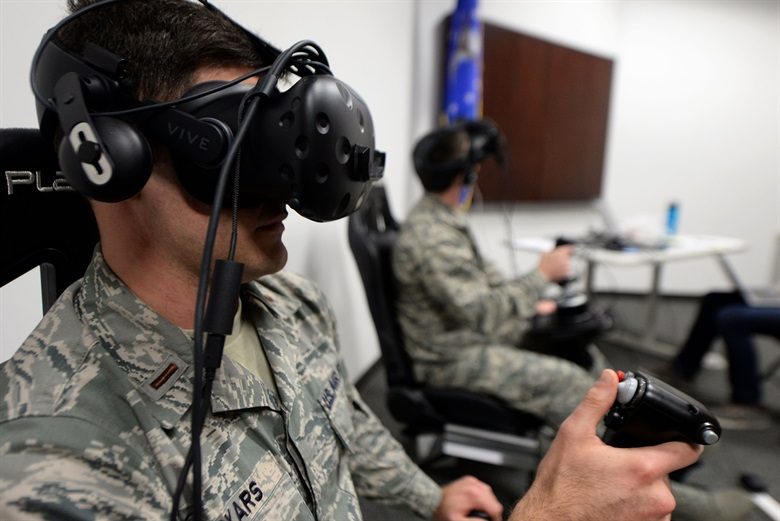TECHNOLOGY
How Virtual Reality is Transforming Military Training

There are some jobs that are difficult to train for.
If you want to be a professional golfer, then you can start playing golf and taking some bad shots until you get good. But if you want to be a lion tamer, then you probably want to be pretty confident even before the first time you’re put in the pen with the lion!
The same goes for military training. While there are exercises and tools that can be used to simulate and approximate warfare, none is able to truly capture the experience of being shot at and having to make life-or-death decisions in a matter of seconds. Fortunately, technology is changing all that and providing a more affordable, more flexible, and ultimately more realistic method for preparing soldiers for battle.
According to LTC Michael Stinchfield of the Combined Arms Center’s Training Innovation Facility at the National Simulation Center, VR experiences are helping to offer ‘better training for soldiers, more efficiently’.
VR equipment is getting more affordable, more accurate, and more immersive. Thanks to this development, it is now being used for a whole range of training scenarios: from mission rehearsals to live fire exercises. And as a result, combatants can test their focus, their reflexes, and their retention of information.
In other words, it’s one thing to sit through a class teaching advanced battle tactics. It’s quite another to be running for cover while your colleagues provide suppressive fire.
Tactical Challenges
Not only does this create a safer and more controlled environment for training, but it also allows instructors to more closely track and monitor performance (thanks to the ability to get advanced metrics from VR applications), as well as to save money on equipment, tools, and even instructors. Instructors can now even provide tutelage remotely!
As one military representative told Samsung:
“One of the benefits of this technology is that it can be used anywhere, making it easier to conduct effective training, in a shorter time frame and in multiple settings.”
Here, VR is being used for tactical exercises and simulations too. Here, the life-life experiences are used to mimic real-life scenarios that military personnel may encounter in the field. That means things like dealing with multiple targets, or following instructions when entering an unsecured building.
More Training Opportunities
The truly amazing thing about VR is that it can be altered to fit any scenario and any training application. Once the basic physics engine is in place, it’s relatively simple for a team of programmers to change parameters, to alter elements of the environment, or to raise or lower the difficulty. That means it can test the broader ability of soldiers as in the previous examples, or it can test the granular independent elements that make up a soldier’s overall ability.
This allows VR to be used in a wide variety of training situations. For instance, VR training will typically begin with a ‘virtual boot camp’ style of experience that can be done with 360 VR video. From there, diverse scenarios can be introduced depending on the needs of that particular service. There may be programs testing physical fitness, skills (such as putting together weaponry), knowledge (identifying certain types of situations or equipment), or even medical training!

Then there are vehicle and flight simulations, that is an ideal application for VR to help augment other forms of training. Here, the VR headsets are typically used in conjunction with simulators that recreate the physical movements of the virtual vehicle. In some cases, this experience can be almost indistinguishable from the real thing!
The army is just one organization that has shown an interest in VR technology. Of course, there are many more potential applications for this game-changing tech. It should come as no surprise that the same medical application is something that has been used to train doctors, surgeons, nurses, and other medical personnel for instance.
Likewise, it is only logical that this is a tool that NASA should also employ. It’s only a matter of time before we see a more widespread use of VR in classrooms. Imagine teaching Egyptology by letting children walk around a simulation of the Great Pyramid of Giza!
Virtual Reality Training the Mind
What’s more though, is that VR can be used to train the brain beyond simply learning and testing skills. The brain is at its most plastic and adaptable when it is focussed and learning. We spend much of our lives sitting down and focusing on a big screen in front of us. The skills that are rewarded in business are those that require us to turn our minds inwards.
But success in combat comes down to being alert and focused: it’s about rapid decision making and quickly identifying potential dangers on the horizon. VR can help to train these abilities by placing us in situations where we are surrounded by virtual opponents, and by forcing us to react quickly and aim true.
As far as our physiology is concerned, this is no different to the real thing. This can trigger something called ‘brain plasticity’ – actually leading to the creation of new neurons and new connections that help to improve brain function. Studies show that people who play computer games have great decision-making skills, along with better visual acuity. Imagine what VR can do for the brain then!
The Future
In the future, we can expect to see VR find its way into more settings. At the same time, its current uses will be expanded throughout the military and beyond.
Of course, resolutions and graphical fidelity will improve. Likewise, inside-out-tracking (a technology that relies on computer vision in order to approximate its position in space) will allow headsets to work ‘untethered’. They will get lighter and they will learn to track all the natural movements of our limbs. In short, they will allow for far more energetic and physical training scenarios.
At the same time, it’s only a matter of time before the military starts combining this technology with other innovations. For instance, ECG readings can be used to look for activation of specific brain areas. This can, in turn, provide vital biofeedback during combat training – so that coaches can see how their team is responding to challenges and help them to remain calmer and more alert. This could all help military personnel to improve their ‘unit cohesion’ – an elusive and crucial concept for surviving combat situations.
Finally, VR training may have particular relevance for a new breed of soldier: those that pilot unmanned drones and other vehicles. For them, all warfare will be remote, VR warfare. What training could be more apt? And as VR technology improves, the potential for this type of control will also improve.
Wrapping Up
In short, VR is currently playing a crucial role in the training of military personnel. However, we are only just scratching the surface of what it is capable of. This technology may be slow to reach mass adoption in the commercial market, but its potential applications spread far beyond that. It will change the way we do business, the way we communicate with friends, and the way that we entertain ourselves. But perhaps most surprisingly, and impactfully; it will change the very way that we wage wars.
Source link
TECHNOLOGY
Next-gen chips, Amazon Q, and speedy S3

AWS re:Invent, which has been taking place from November 27 and runs to December 1, has had its usual plethora of announcements: a total of 21 at time of print.
Perhaps not surprisingly, given the huge potential impact of generative AI – ChatGPT officially turns one year old today – a lot of focus has been on the AI side for AWS’ announcements, including a major partnership inked with NVIDIA across infrastructure, software, and services.
Yet there has been plenty more announced at the Las Vegas jamboree besides. Here, CloudTech rounds up the best of the rest:
Next-generation chips
This was the other major AI-focused announcement at re:Invent: the launch of two new chips, AWS Graviton4 and AWS Trainium2, for training and running AI and machine learning (ML) models, among other customer workloads. Graviton4 shapes up against its predecessor with 30% better compute performance, 50% more cores and 75% more memory bandwidth, while Trainium2 delivers up to four times faster training than before and will be able to be deployed in EC2 UltraClusters of up to 100,000 chips.
The EC2 UltraClusters are designed to ‘deliver the highest performance, most energy efficient AI model training infrastructure in the cloud’, as AWS puts it. With it, customers will be able to train large language models in ‘a fraction of the time’, as well as double energy efficiency.
As ever, AWS offers customers who are already utilising these tools. Databricks, Epic and SAP are among the companies cited as using the new AWS-designed chips.
Zero-ETL integrations
AWS announced new Amazon Aurora PostgreSQL, Amazon DynamoDB, and Amazon Relational Database Services (Amazon RDS) for MySQL integrations with Amazon Redshift, AWS’ cloud data warehouse. The zero-ETL integrations – eliminating the need to build ETL (extract, transform, load) data pipelines – make it easier to connect and analyse transactional data across various relational and non-relational databases in Amazon Redshift.
A simple example of how zero-ETL functions can be seen is in a hypothetical company which stores transactional data – time of transaction, items bought, where the transaction occurred – in a relational database, but use another analytics tool to analyse data in a non-relational database. To connect it all up, companies would previously have to construct ETL data pipelines which are a time and money sink.
The latest integrations “build on AWS’s zero-ETL foundation… so customers can quickly and easily connect all of their data, no matter where it lives,” the company said.
Amazon S3 Express One Zone
AWS announced the general availability of Amazon S3 Express One Zone, a new storage class purpose-built for customers’ most frequently-accessed data. Data access speed is up to 10 times faster and request costs up to 50% lower than standard S3. Companies can also opt to collocate their Amazon S3 Express One Zone data in the same availability zone as their compute resources.
Companies and partners who are using Amazon S3 Express One Zone include ChaosSearch, Cloudera, and Pinterest.
Amazon Q
A new product, and an interesting pivot, again with generative AI at its core. Amazon Q was announced as a ‘new type of generative AI-powered assistant’ which can be tailored to a customer’s business. “Customers can get fast, relevant answers to pressing questions, generate content, and take actions – all informed by a customer’s information repositories, code, and enterprise systems,” AWS added. The service also can assist companies building on AWS, as well as companies using AWS applications for business intelligence, contact centres, and supply chain management.
Customers cited as early adopters include Accenture, BMW and Wunderkind.
Want to learn more about cybersecurity and the cloud from industry leaders? Check out Cyber Security & Cloud Expo taking place in Amsterdam, California, and London. Explore other upcoming enterprise technology events and webinars powered by TechForge here.
TECHNOLOGY
HCLTech and Cisco create collaborative hybrid workplaces

Digital comms specialist Cisco and global tech firm HCLTech have teamed up to launch Meeting-Rooms-as-a-Service (MRaaS).
Available on a subscription model, this solution modernises legacy meeting rooms and enables users to join meetings from any meeting solution provider using Webex devices.
The MRaaS solution helps enterprises simplify the design, implementation and maintenance of integrated meeting rooms, enabling seamless collaboration for their globally distributed hybrid workforces.
Rakshit Ghura, senior VP and Global head of digital workplace services, HCLTech, said: “MRaaS combines our consulting and managed services expertise with Cisco’s proficiency in Webex devices to change the way employees conceptualise, organise and interact in a collaborative environment for a modern hybrid work model.
“The common vision of our partnership is to elevate the collaboration experience at work and drive productivity through modern meeting rooms.”
Alexandra Zagury, VP of partner managed and as-a-Service Sales at Cisco, said: “Our partnership with HCLTech helps our clients transform their offices through cost-effective managed services that support the ongoing evolution of workspaces.
“As we reimagine the modern office, we are making it easier to support collaboration and productivity among workers, whether they are in the office or elsewhere.”
Cisco’s Webex collaboration devices harness the power of artificial intelligence to offer intuitive, seamless collaboration experiences, enabling meeting rooms with smart features such as meeting zones, intelligent people framing, optimised attendee audio and background noise removal, among others.
Want to learn more about cybersecurity and the cloud from industry leaders? Check out Cyber Security & Cloud Expo taking place in Amsterdam, California, and London. Explore other upcoming enterprise technology events and webinars powered by TechForge here.
TECHNOLOGY
Canonical releases low-touch private cloud MicroCloud

Canonical has announced the general availability of MicroCloud, a low-touch, open source cloud solution. MicroCloud is part of Canonical’s growing cloud infrastructure portfolio.
It is purpose-built for scalable clusters and edge deployments for all types of enterprises. It is designed with simplicity, security and automation in mind, minimising the time and effort to both deploy and maintain it. Conveniently, enterprise support for MicroCloud is offered as part of Canonical’s Ubuntu Pro subscription, with several support tiers available, and priced per node.
MicroClouds are optimised for repeatable and reliable remote deployments. A single command initiates the orchestration and clustering of various components with minimal involvement by the user, resulting in a fully functional cloud within minutes. This simplified deployment process significantly reduces the barrier to entry, putting a production-grade cloud at everyone’s fingertips.
Juan Manuel Ventura, head of architectures & technologies at Spindox, said: “Cloud computing is not only about technology, it’s the beating heart of any modern industrial transformation, driving agility and innovation. Our mission is to provide our customers with the most effective ways to innovate and bring value; having a complexity-free cloud infrastructure is one important piece of that puzzle. With MicroCloud, the focus shifts away from struggling with cloud operations to solving real business challenges” says
In addition to seamless deployment, MicroCloud prioritises security and ease of maintenance. All MicroCloud components are built with strict confinement for increased security, with over-the-air transactional updates that preserve data and roll back on errors automatically. Upgrades to newer versions are handled automatically and without downtime, with the mechanisms to hold or schedule them as needed.
With this approach, MicroCloud caters to both on-premise clouds but also edge deployments at remote locations, allowing organisations to use the same infrastructure primitives and services wherever they are needed. It is suitable for business-in-branch office locations or industrial use inside a factory, as well as distributed locations where the focus is on replicability and unattended operations.
Cedric Gegout, VP of product at Canonical, said: “As data becomes more distributed, the infrastructure has to follow. Cloud computing is now distributed, spanning across data centres, far and near edge computing appliances. MicroCloud is our answer to that.
“By packaging known infrastructure primitives in a portable and unattended way, we are delivering a simpler, more prescriptive cloud experience that makes zero-ops a reality for many Industries.“
MicroCloud’s lightweight architecture makes it usable on both commodity and high-end hardware, with several ways to further reduce its footprint depending on your workload needs. In addition to the standard Ubuntu Server or Desktop, MicroClouds can be run on Ubuntu Core – a lightweight OS optimised for the edge. With Ubuntu Core, MicroClouds are a perfect solution for far-edge locations with limited computing capabilities. Users can choose to run their workloads using Kubernetes or via system containers. System containers based on LXD behave similarly to traditional VMs but consume fewer resources while providing bare-metal performance.
Coupled with Canonical’s Ubuntu Pro + Support subscription, MicroCloud users can benefit from an enterprise-grade open source cloud solution that is fully supported and with better economics. An Ubuntu Pro subscription offers security maintenance for the broadest collection of open-source software available from a single vendor today. It covers over 30k packages with a consistent security maintenance commitment, and additional features such as kernel livepatch, systems management at scale, certified compliance and hardening profiles enabling easy adoption for enterprises. With per-node pricing and no hidden fees, customers can rest assured that their environment is secure and supported without the expensive price tag typically associated with cloud solutions.
Want to learn more about cybersecurity and the cloud from industry leaders? Check out Cyber Security & Cloud Expo taking place in Amsterdam, California, and London. Explore other upcoming enterprise technology events and webinars powered by TechForge here.
-

 SEO7 days ago
SEO7 days agoGoogle Limits News Links In California Over Proposed ‘Link Tax’ Law
-

 SEARCHENGINES6 days ago
SEARCHENGINES6 days agoGoogle Core Update Volatility, Helpful Content Update Gone, Dangerous Google Search Results & Google Ads Confusion
-

 SEO6 days ago
SEO6 days ago10 Paid Search & PPC Planning Best Practices
-

 MARKETING7 days ago
MARKETING7 days ago2 Ways to Take Back the Power in Your Business: Part 2
-

 MARKETING5 days ago
MARKETING5 days ago5 Psychological Tactics to Write Better Emails
-

 SEARCHENGINES5 days ago
SEARCHENGINES5 days agoWeekend Google Core Ranking Volatility
-

 PPC7 days ago
PPC7 days agoCritical Display Error in Brand Safety Metrics On Twitter/X Corrected
-

 MARKETING6 days ago
MARKETING6 days agoThe power of program management in martech














You must be logged in to post a comment Login